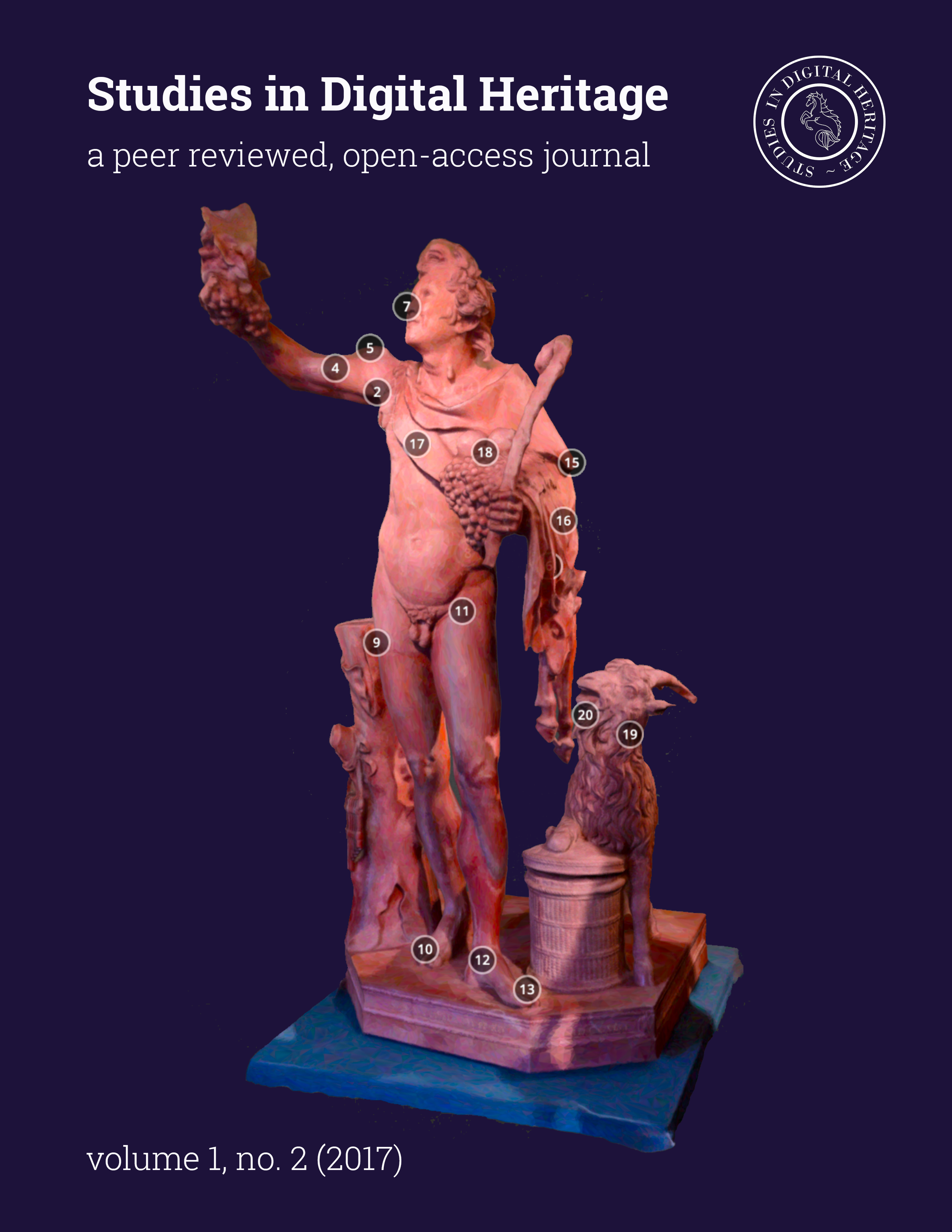The Fortress of Riolo Terme, near Ravenna: digital survey and 3D printing for cultural dissemination
Main Article Content
Abstract
In this work, initially developed as a thesis project, it has been studied the management of the different information methods, derived from the 3D laser scanner survey, of the Fortress of Riolo Terme, near Ravenna, Italy. After studying the building and its history this type of survey has been chosen because of its fast acquisition of three-dimensional data, with the advantage of a level of details and a resolution impossible to be reached by other methods. The geometrical survey of the whole fortress and its surroundings has been enriched by the gathering of color information: taking a specific set of photos for every station, each single scan has been associated to a panoramic image, obtaining a point clouds provided with the corresponding color values.
Given the complexity and articulation of the building part of the project was dedicated to the work program, in terms of the decimation of the data, balancing a fluid management of the vast amount of collected data, and the conservation of the appropriate resolution of the information. This brought to the creation of an automatism both for the alignment of the scans, and for the following graphic post-processing. In addition to the production of drawings as plans, elevations and sections, whose outlining has been automated by creating several procedures for Autodesk AutoCAD, a specific part of the project was aimed at the construction of an optimized model of a portion of the building, to be printed out using 3D technology.
The project allowed investigating thoroughly an architectural complex that is an outcome of stratifications over time, from the XIV century until the contemporary age. The chosen approach and the type of products elaborated are part of a renovation project for the enjoyment and historical knowledge of the building, which was the primary aim of this work.Downloads
Article Details
From 18 May 2018, the contents of Studies in Digital Heritage are licensed under a Creative Commons Attribution-NonCommercial 4.0 International License (CC BY-NC 4.0). Our submitting authors pay no fee and retain the copyright to their own work.
How this works: to submit their work to the journal, authors grant Studies in Digital Heritage a nonexclusive license to distribute the work according to a CC BY-NC 4.0 license. Once an article is published, anyone is free to share and adapt its contents—provided only that they do so for noncommercial purposes and properly attribute the shared or adapted information. Details of these terms can be found on the Creative Commons website.
Download SDH’s full author agreement here
Studies in Digital Heritage will insert the following note at the end of any work published in the journal:
© [Year] by the authors. This article is an open-access article distributed under the terms and conditions of the Creative Commons Attribution License CC BY-NC 4.0 (https://creativecommons.org/licenses/by-nc/4.0/).
References
Ancarani, L., M. Morigi and S. Tamburini. 2012. Museo del paesaggio dell'appennino faentino, Ravenna: Angelo Longo Editore.
Barrile, V., G. Bilotta, D. Lamari. 2017. 3D models of Cultural Heritage, International Journal of Mathematical Models and Methods in Applied Sciences 11, 2017, 1-8.
Battini C. and M. Bini. 2007. Nuove immagini di monumenti fiorentini. Rilievi con tecnologia scanner laser 3D, Firenze: Alinea.
Böhm J. and M. Pateraki. 2006. From Point Samples to Surfaces - On Meshing and Alternatives, ISPRS Commission V Symposium ‘Image Engineering and Vision Metrology’, 2006, 50-55.
Costa, L. 1987. Aspetti inediti di storia romagnola, Il castello di Riolo e gli ultimi pertinaci paladini di Caterina Sforza, Faenza: Tipografia faentina.
Costa, L. 1992. Nascita e sviluppo di un castello medioevale, Torricelliana, 266-297.
Douglas, D. and T. Peucker. 1973. Algorithms for the Reduction of the Number of Points Required to Represent a Digitized Line or its Caricature, The Canadian Cartographer 10(2) (1973), 112– 122. DOI: 10.3138/FM57-6770-U75U-7727
Hershberger, J. and J. Snoeyink. 1992. Speeding-up the Douglas-Peucker Line-Simplification Algorithm, University of British Columbia Vancouver, BC, Canada.
Hess, M. and S. Robson. 2010. 3D colour imaging for cultural heritage artefacts, International Archives of the Photogrammetry, Remote Sensing and Spatial Information Sciences - ISPRS Archives 38 (PART 5), 288-292.
Monti, A. 2002. Riolo e la sua Rocca, Appunti di storia e d’archeologia, Imola: Bacchilega Editore.
Pavlidis, G., A. Koutsoudis, F. Arnaoutoglou, V. Tsioukas, C. Chamzas. 2007. Methods for 3D Digitization of Cultural Heritage, Journal of Cultural Heritage 8 (2007), 93-98.
Pieraccini, M., G. Guidi, C. Atzeni. 2001. 3D Digitizing of Cultural Heritage, Journal of Cultural Heritage 2 (2001), 63−70.
Piersanti, C. and R. Rava. 2000. La rocca ritrovata, il restauro del complesso fortificato di Riolo Terme, Milano: Skira.
Sacerdote, F. and G. Tucci. 2007. Sistemi a scansione per l’architettura e il territorio, Firenze: Alinea.
Sfikas, K., I. Pratikakis, A. Koutsoudis., M. Savelonas, T. Theoharis. 2016, Partial Matching of 3D Cultural Heritage Objects Using Panoramic Views, Multimedia Tools and Applications, April 2016. DOI: 10.1007/s11042-014-2069-0
Vassena, G. P. M. and M. Sgrenzaroli. 2007. Tecniche di rilevamento tridimensionale tramite laser scanner, Milano: Selecta.
Verdiani, G. 2012. Rilievo digitale 3D, le metodologie e le strumentazioni per il rilievo laser scanner, Tipologie delle strumentazioni per il rilievo digitale. In: S. Bertocci, M. Bini. Manuale di rilievo architettonico e urbano, Novara: Città studi Edizioni, De Agostini, 169-197.
Wood, R. W. 1911. Physical Optics, The Macmillan Company, New York.
Wu S.-T. and M. Rocìo Gonzales Màrquez. 2003. A Non-self-intersection Douglas-Peucker Algorithm, SIBGRAPI 2003, 60-66.


